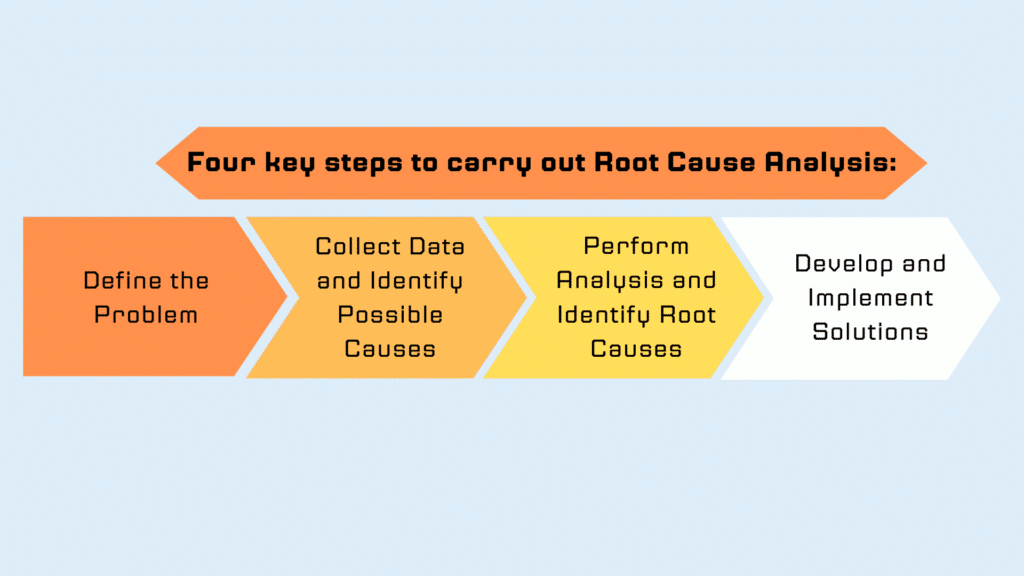Root Cause Analysis (RCA) is crucial for organizations as it provides a structured and systematic approach to understanding the underlying factors contributing to problems or failures. By identifying the root causes rather than merely addressing symptoms, RCA helps organizations implement targeted and sustainable solutions.
This proactive approach not only resolves immediate issues but also prevents their recurrence, leading to improved operational efficiency and product/service quality. Root Cause Analysis (RCA) fosters a culture of continuous improvement, empowering organizations to learn from past challenges and enhance their processes over time. Moreover, by pinpointing the root causes, RCA enables strategic decision-making, resource allocation, and the development of preventive measures, ultimately contributing to the long-term success and resilience of an organization in today’s dynamic and competitive business environment.
Here are four key steps to carry out Root Cause Analysis:
Define the Problem:
- Clearly articulate and define the problem or issue. Ensure that the problem is well-defined and specific, avoiding vague or broad descriptions.
- Use tools such as problem statements, data analysis, or input from relevant stakeholders to precisely identify the scope and nature of the problem.
Collect Data and Identify Possible Causes:
- Gather relevant data related to the problem. This may include quantitative data, observations, interviews, or any other information that can provide insights.
- Brainstorm and create a list of potential causes. Encourage input from team members, subject matter experts, or those directly involved in the process. Use techniques like the “5 Whys” or fishbone diagrams (Ishikawa diagrams) to explore various dimensions of the issue.
Perform Analysis and Identify Root Causes:
- Analyze the data collected and assess the potential causes identified. Use critical thinking to evaluate the evidence and eliminate unlikely or less impactful causes.
- Apply appropriate analytical tools and techniques, such as Pareto analysis, to prioritize and narrow down the list of potential causes.
- Utilize the “5 Whys” technique, continuously asking why a problem occurred until you reach the fundamental cause. This helps in digging deeper and identifying root causes rather than addressing symptoms.
Develop and Implement Solutions:
- Once the root causes are identified, develop effective and targeted solutions to address each root cause. Consider the feasibility, cost-effectiveness, and impact of each proposed solution.
- Implement the chosen solutions and monitor their effectiveness over time. It’s important to track the outcomes and ensure that the implemented changes address the root causes and lead to sustained improvement.
- Establish preventive measures to avoid recurrence of the identified root causes. This may involve updating processes, providing training, or instituting new policies.
Throughout the Root Cause Analysis process, effective communication is crucial. Engage relevant stakeholders, keep them informed about the progress, and involve them in decision-making. RCA is an iterative process, and continuous improvement is fostered by learning from each analysis and applying lessons to future problem-solving efforts.
Conclusion
Root Cause Analysis emerges as an indispensable tool for organizations striving for excellence in their operations. By delving beyond surface-level manifestations of problems and addressing their fundamental origins, RCA not only facilitates the resolution of immediate issues but also instills a proactive culture of continuous improvement. The significance of RCA lies in its ability to guide organizations towards sustainable solutions, prevent the recurrence of problems, and promote informed decision-making.
Through the iterative process of identifying and addressing root causes, organizations can enhance their overall efficiency, product/service quality, and adaptability to changing circumstances. As a strategic methodology, Root Cause Analysis proves invaluable in building resilient and responsive organizations that can navigate challenges and evolve in an ever-evolving business landscape.

